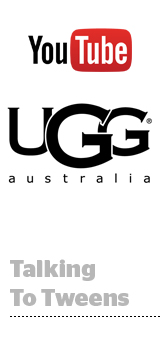 When your target audience is tween girls aged nine to 13, there are not only data and targeting considerations to keep in mind but also a general elusiveness from a media consumption standpoint.
When your target audience is tween girls aged nine to 13, there are not only data and targeting considerations to keep in mind but also a general elusiveness from a media consumption standpoint.
When UGG Australia came out with a new “I Heart UGG” brand line, YouTube stood out to its agency, Santa Monica-based Palisades Media Group, because of the tween-saturated fan base its creators have built.
“Because of the unique demographic we were trying to reach, we had to take a more unique approach in how we reached that audience, which was very much contextually based and didn’t use traditional data targeting,” commented Jeremy Viola, VP and group director of strategy at Palisades Media Group.
Initially an offline campaign, Palisades sponsored an in-store appearance with YouTube girl band sensation Cimorelli, which sparked a screaming frenzy reminiscent of a Michael Jackson performance, according to its client.
The agency wanted to replicate that interest online, but it wasn’t easy. “If you can’t always afford to partner with [celebrity creators who typically command higher CPMs] where else do you look on YouTube to ensure channels are high-quality?” Viola said.
To build essentially its own YouTube “network,” Palisades tapped Outrigger Media’s OpenSlate, a tool that assesses and scores 220,000 YouTube channels based on measures of influence, content quality and engagement.
The platform assigns a SlateScore that filters out suggestive content or profanity. Advertiser demand for OpenSlate drove the rollout of a tool allowing media planners to curate their own premium content networks from among approximately 70 million ad-supported YouTube videos. That tool, called Vnetic, rolled out in June.
Palisades has tested and utilized many of YouTube’s video delivery options. Viola described YouTube’s TrueView as “very attractive in terms of users self-selecting the relevancy of the video,” and said YouTube’s non-skippable formats deliver very efficient cost-per-completed-view impressions. However for the purposes of the UGG campaign, it has settled on YouTube’s non-skippable, 15-second preroll format.
Via a content and audience-scoring algorithm, OpenSlate siphoned the most relevant tween channels from the pack, including channels like Clevver News and Bethany Mota, where topics like music, beauty and back-to-school were part of the conversation.
In this instance with OpenSlate, the agency went with preroll, but is also looking to combine that with more custom programs on a direct basis with appropriate influencers, Viola said.
Through Vnetic, users can build custom premium content networks within YouTube. Those networks can be targeted via any YouTube buying platform, including AdWords, AdX or programmatically through any DSP.
The I Heart UGG campaign used OpenSlate datasets (produced with the Vnetic planning tool) to target media in the auction via AdWords. When using OpenSlate for enhanced targeting and analytics, Palisades found “5X the efficiency in cost-per-view” than in video campaigns without, according to the agency. Viola said that in addition to OpenSlate, they’re running back-end analysis against ComScore Validated Essentials and demographic data.
“We’re able to see (anonymous) back-end metrics for how long someone’s spent on site, whether someone’s looked up one of our flagship store locations, and we’re using that information to determine who is delivering the most quality audience, most efficiently,” Viola said.
Although Viola acknowledges the agency’s direct-response advertisers are dabbling much more in programmatic buying, on the brand advertiser side – particularly when you consider a brand like UGG with audience sensitivities – having certainty that impressions are running on a brand-safe, and closed-loop environment like YouTube, has been key.













